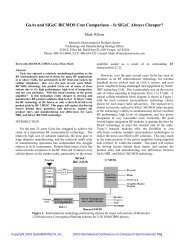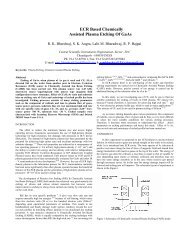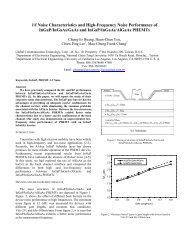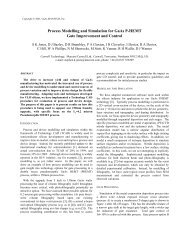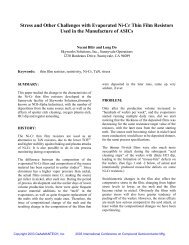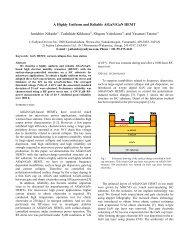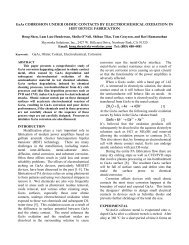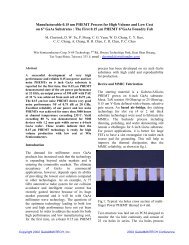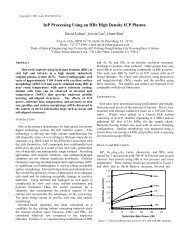Building Solder Bumps on GaAs Flip Chip Schottky ... - CS Mantech
Building Solder Bumps on GaAs Flip Chip Schottky ... - CS Mantech
Building Solder Bumps on GaAs Flip Chip Schottky ... - CS Mantech
Create successful ePaper yourself
Turn your PDF publications into a flip-book with our unique Google optimized e-Paper software.
<str<strong>on</strong>g>Building</str<strong>on</strong>g> <str<strong>on</strong>g>Solder</str<strong>on</strong>g> <str<strong>on</strong>g>Bumps</str<strong>on</strong>g> <strong>on</strong> <strong>GaAs</strong> <strong>Flip</strong> <strong>Chip</strong> <strong>Schottky</strong> DevicesPrasit SricharoenchaikitM/A-COM, Inc., 43 South Ave., Burlingt<strong>on</strong>, MA 01803 USA (781) 564-3082, sricharp@tycoelectr<strong>on</strong>ics.comKEYWORDS: under bump metallurgy (UBM), plating, photolithography, solder bumps, high temperature reverse bias (HTRB), and JointElectr<strong>on</strong> Devices Engineering Council (JEDEC)AbstractThe semic<strong>on</strong>ductor industry has made ast<strong>on</strong>ishingimprovements in decreasing circuit dimensi<strong>on</strong>s and moreimportantly, greater performance. Making c<strong>on</strong>necti<strong>on</strong>s withgold c<strong>on</strong>tacts <strong>on</strong> <strong>GaAs</strong> devices using solder bumps instead ofsilver Epoxy offers lower c<strong>on</strong>tact resistance and hence, betterperformance. Further more, solder bump applicati<strong>on</strong> to <strong>GaAs</strong>devices is amenable to high volume producti<strong>on</strong> and ease ofmanufacturing. Benefits from using solder bumps then becomeobvious for c<strong>on</strong>necti<strong>on</strong>s. This paper describes a processdevelopment using our existing technology of wafer processingin both wet and dry chemistries to build solder bumps <strong>on</strong> <strong>GaAs</strong>wafer for flip chip <strong>Schottky</strong> devices. Eutectic Sn/Pb solderbumps and Pb-free solder bumps were investigated. Detailedprocessing and chemistry will be discussed. Reliability ofsolder bumps <strong>on</strong> <strong>GaAs</strong> flip chip <strong>Schottky</strong> devices will also bepresented.All indicati<strong>on</strong>s and predicti<strong>on</strong>s suggest that in order to meetfuture requirement, the packaging & c<strong>on</strong>necti<strong>on</strong> formicroelectr<strong>on</strong>ic industry has to adopt and employ solderbump technology. Comparing with stenciling and roboticball placement, the electroplating technique is more costeffective for building solder bumps <strong>on</strong> wafers especiallywhen ball pitch is much smaller. 2SOLDER BUMP PROCESSIn additi<strong>on</strong> to many device fabricati<strong>on</strong> processes, solderbump process requires photolithography and platingtechnologies. The entire solder bump process is describedin the following schematic diagram in figure 1.a) UV exposed resist for platingb) Resist developed to expose UBMINTRODUCTIONMicroelectr<strong>on</strong>ic industry has been making a tremendousimprovement toward miniaturizati<strong>on</strong> of circuitry withgreater performance. Similarly the packaging and assemblyof integrated circuits (IC) is aggressively making the effortto follow the microelectr<strong>on</strong>ic trend. Making c<strong>on</strong>necti<strong>on</strong>swith gold c<strong>on</strong>tacts <strong>on</strong> <strong>GaAs</strong> devices using solder bumpsinstead of silver Epoxy offers lower c<strong>on</strong>tact resistance andhence, better performance. Further more, solder bumpapplicati<strong>on</strong> to <strong>GaAs</strong> devices is amenable to high volumeproducti<strong>on</strong> and ease of manufacturing, especially whencircuit dimensi<strong>on</strong>s are getting smaller and smaller.Requirement of solder bumps for advanced packaging hascreated excitements am<strong>on</strong>g industries, especially equipmentmanufacturers, chemical suppliers and wafer fab. Thispresents not <strong>on</strong>ly a challenge to the industries but also agreat opportunity for creativity and competitiveness. In fact,new c<strong>on</strong>sortiums like Semic<strong>on</strong>ductor Equipment C<strong>on</strong>sortiumfor Advanced Packaging (SECAP) and Advanced Packagingand Interc<strong>on</strong>nect Alliance (APiA) have been formed recentlyto address these matters. 1 Many semic<strong>on</strong>ductor companies,e.g., Nati<strong>on</strong>al Semic<strong>on</strong>ductor, TI, Motorola, Fujitsu,Samsung, Hyundai and many others, are aggressivelyadapting and employing wafer-level chip scale packaging(WL-<strong>CS</strong>P) using solder bumps. To meet future’s demand,the industry is c<strong>on</strong>stantly searching for both viable techniqueand more importantly, cost effective way to achieve its goal.Resist UV exposed resist ResistTiWSputtered Cu or Au seedTiWSubstratec) Removal of top TiWResistResistTiWTiWSputtered Cu or Au seedTiWSubstratee) Sn/Pb bump plating <strong>on</strong> CuSn/PbResistPlated CuTiWTiWSputtered Cu or Au seedTiWSubstrateg) Removal of top TiWSn/PbPlated CuSputtered Cu or Au seedTiWSubstrateResistResistTiWSputtered Cu or Au seedTiWSubstrated) Cu plating <strong>on</strong> UBM seed layerResistResistPlated CuTiWTiWSputtered Cu or Au seedTiWSubstratef) Resist removal after Sn/Pb bump platingSn/PbPlated CuTiWTiWSputtered Cu or Au seedTiWSubstrateh) Removal of sputterred UBM seed layerSn/PbPlated CuSputtered Cu or Au seedTiWSubstrate
Substratei) Removal of bottom TiWSn/PbPlated CuSputterred Cu or AuTiWj) Reflow of solder bumpsFigure 1. Schematic diagram of solder bump process.Sn/PbSubstrateUNDER BUMP METALLURGY (UBM)A selecti<strong>on</strong> of appropriate under bump metallurgy(UMB) is critically important because it serves as afoundati<strong>on</strong> <strong>on</strong> which the solder bump is built. There is adirect relati<strong>on</strong>ship between how good the UMB and thebump adhesi<strong>on</strong>. Two types of UBM were experimented.One was TiW/Cu/TiW (1000 Aº/4000Aº/75Aº) and the otherwas TiW/Au/TiW (200 Aº/2250Aº/100Aº) as UBM forsolder bump process. One set of wafers was sputtered withTiW/Cu/TiW (1000 Aº/4000Aº/75Aº) and the other set wassputtered with TiW/Au/TiW (200 Aº/2250Aº/100Aº). It hasbeen tested that either type of UBM can be used as seedlayer for plating.PHOTOLITHOGRAPHYPhotolithography process is employed to create anexposed area <strong>on</strong> which solder bump is deposited usingelectroplating. G-line resist (465 nm) and I-line (365 nm)resist are comm<strong>on</strong>ly employed in the industry. Minimumresist thickness depends largely <strong>on</strong> the bump height. Ingeneral, the thicker the resist the better the c<strong>on</strong>trol of aplating process and hence, the better uniformity of solderbumps. The following resists had been experimented, i.e.,AZ4620 (Clariant), SPR220 (Shipley) and experimentalresist ‘TFP-V” (Clariant) which could impart 65 µm fromsingle coating. All resists tested are acceptable for platingprocess. The SPR220 has been employed in our producti<strong>on</strong>line with 26 µm resist thickness.required to deposit 6 µm of Cu, often called copper post.Subsequently, eutectic Sn/Pb (either 63/37 or 5/95) platingor Pb-free solder bump plating is performed. The eutecticSn/Pb plating chemicals from two manufacturers, i.e.,Ent<strong>on</strong>e-OMI and Technic, had been experimented andproven to be equally good. Due to c<strong>on</strong>cerns of envir<strong>on</strong>mentand alpha particle emissi<strong>on</strong>, the microelectr<strong>on</strong>ic industry ismoving toward Pb-free solder bump (even though still manyyears away). The Pb-free solder plating had also beenexperimented using Shipley’s <str<strong>on</strong>g>Solder</str<strong>on</strong>g><strong>on</strong> BP TC 2000 (Sn/Cu:98-99%/2-1%). The Pb-free solder bumps had beensuccessfully dem<strong>on</strong>strated (see figures 3 and 5).FIELD REMOVAL PROCESSWhen solder plating and resist removal steps (using ST-23 from ATMI) are completed. It is necessary to removefield metal, i.e., either TiW/Cu/TiW or TiW/Au/TiW. Wehave many wet chemistries in house and been able to use inhousechemicals to remove the field metal. It is importantthat chemicals used for field metal removal will not attack<strong>GaAs</strong> surface. We have dem<strong>on</strong>strated that top TiW can beremoved using either a) wet chemistry, e.g., H 2 O 2 or b) dryetch, e.g., SF 6 . Both Cu seed and Au seed can be removedusing commercially available CN complexing chemical (forexample from Technic). This chemical will react with Cu-or Au and form Cu(CN) 2 or Au complex respectively. 4Similarly, bottom TiW can be removed using same wetchemistry as the <strong>on</strong>e used for top TiW removal. When allfield metal is removed, the plated structure of bump lookslike mushroom as shown in figure 2 for eutectic Sn/Pb(63/37) bump and figure 3 for Pb-free bump (Sn/Cu: 98-99%/2-1%).PLATING PROCESSPlating technology has been used for many years in otherindustries. Only recently, the microelectr<strong>on</strong>ics industry hasrealized the benefits and advantages of employing thistechnology. With combinati<strong>on</strong> of photolithography andplating processes, metal can be deposited selectively <strong>on</strong>wafers, resulting in desirable patterns of metal deposit.Accordingly, the plating technique is used to build solderbumps <strong>on</strong> wafers. The solder bump process requires twoplating processes. Before plating can begin, exposed TiW(an adhesi<strong>on</strong> promoter for resist) must be removed to exposecopper or gold seed layer before copper plating. This canbe accomplished by either a) wet etch using H 2 O 2 or b) dryetch using SF 6 . 3 These chemistries have been tested andthey both are effective. Once TiW is removed, Cu plating isFigure 2. Before reflow.REFLOW OF SOLDER BUMPSFigure 3. Pb-free before reflow.Eutectic temperatures of Sn/Pb (63/37), Sn/Pb (5/95),and Sn/Cu (99/1) are 183 °C, 314 °C and 227 °Crespectively. Typically, a reflow temperature is higher thanthe eutectic temperature. In additi<strong>on</strong>, an applicati<strong>on</strong> of flux(e.g., RMA #5 from Indium Corporati<strong>on</strong>) to the bumpsbefore reflow step will promote nice formati<strong>on</strong> of sphericalbumps. Figure 4 shows results of Sn/Pn (63/37) after reflow@ 235 °C and figure 5 shows results of Sn/Cu (98-99%/2-1%) after reflow @ 245 °C.
1312.5Vb: Pre Burn-In vs Post Burn-IN1211.5Figure 4. After reflow.Figure 5. Pb-free bump.It is postulated that flux not <strong>on</strong>ly prevents oxidati<strong>on</strong> of Snfrom Sn/Pb or Sn/Cu but also promotes a reducti<strong>on</strong> ofpreviously formed SnO and SnO 2 <strong>on</strong> bump surface resultingin nice hemispheric structures of the solder bumps as shownin figures 4 and 5. The flux can be removed easily usingcommercial resist stripping chemical, e.g., ST-23. Figures 6and 7 show Sn/Pb (63/37) bumps <strong>on</strong> <strong>GaAs</strong> flip chip<strong>Schottky</strong> devices (GF<strong>CS</strong>4) before and after reflowrespectively. Devices after reflow have been separated bydicing but still mounted <strong>on</strong> tape as shown in figure 7.Vb, Volts1110.5109.59Pre-Vb, voltsPost-Vb, volts0 5 10 15 20 25 30 35 40 45 50 55Die #Figure 9. Vb before and after HTRB.0.40.350.3Ct: Pre Burn-In vs Post Burn-In0.25Ct, pF0.20.15Pre-Ct, pFPost-Ct, pF0.10 5 10 15 20 25 Die # 30 35 40 45 50 55Figure 6. Before reflow.Figure 7. After reflow.Figure 10. Ct before and after HTRB.RELIABILITYHaving a solder bump process, <strong>GaAs</strong> wafer for flip chip<strong>Schottky</strong> devices was processed with solder bumps. Afterseparati<strong>on</strong>, flip chip <strong>Schottky</strong> devices were subjected to areliability test using high temperature reverse bias (HTRB),150 °C, 5 volts for 48 hr. Figures 8,9,10, and 11 showresults of 52 devices before and after HTRB of forwardvoltage (Vf), breakdown voltage (Vb), total capacitance (Ct)and series resistance (Rs) respectively.Rs, Ohms1412108642Rs: Pre Burn-In vs Post Burn-InPre-Rs, OhmPost-Rs, Ohm0.730.720.71Pre Burn-In Vf vs Post Burn-In VfHTRB: 150 C, 5 Volts, 4800 5 10 15 20 25 Die # 30 35 40 45 50 55Figure 11. Rs before and after HTRB.Vf, volts0.70.690.680.67Pre-Vf, voltsPost-Vf, volts0 5 10 15 20 25 30 35 40 45 50 55Die #Figure 8. Vf before and after HTRB.Preliminary results of the burn-in test certainly indicatethat building of solder bumps <strong>on</strong> <strong>GaAs</strong> wafer for flip chip<strong>Schottky</strong> devices presents no reliability issue. Even thoughfirst phase of the burn-in period was <strong>on</strong>ly for 48 hr., aninfant mortality failure, if it were to happen, would mostlikely occur during this initial period. These devicesc<strong>on</strong>tinue to be tested using HTRB for a l<strong>on</strong>g-term reliabilitystudy (i.e., 1000 hr.) and such burn-in test is still in progress.
BUMP SHEAR TESTBump shear test was c<strong>on</strong>ducted to test the adhesi<strong>on</strong> andshear strength of the plated solder bumps using Dage2400PC System and the test was performed according to thetest method of JEDEC Standard No. B117. 5 ForSn/Pb(63/37) bumps with 48 µm height, 150 um in diameter,tip of probe from module surface was 7.62 µm with a shearrate of 127 µm/sec. For Sn/Pb(5/95) bumps with 11 µmheight, 150 um in diameter, the tip of probe from modulesurface was 2.54 µm with a shear rate of 127 µm/sec. <str<strong>on</strong>g>Bumps</str<strong>on</strong>g>hear tests were d<strong>on</strong>e at room temperature and an average of20 measurements was taken. Shear strengths of Sn/Pb(63/37) and Sn/Pb (5/95) bumps were 85 gm/bump and 173gm/bump respectively. These results indicate good shearstrength from both types. Bases from which the bumps weresheared off exhibited intermetallic fracture of Sn/Pbmaterial. This represents the failure mode # 1 which is anacceptable failure mode, according to JEDEC Standard No.B117. 5 Figures 12 shows results of the bases after thebumps of both Sn/Pb (5/95) and Sn/Pb (63/37) were shearedoff.After Shear TestSnPb (9/95) SnPb (63/37)technique. This investigati<strong>on</strong> merely represents a feasibilitystudy and it is dem<strong>on</strong>strated that fabricati<strong>on</strong> of solder bumps<strong>on</strong> small devices such as <strong>GaAs</strong> flip chip <strong>Schottky</strong> devices ispossible.CONCLUSIONWe have successfully dem<strong>on</strong>strated an ability to buildsolder bumps (Sn/Pb and Pb-free) <strong>on</strong> devices. Severaldevices had been built with solder bumps. <strong>GaAs</strong> flip chip<strong>Schottky</strong> devices with solder bumps have been subjected toreliability test using high temperature reverse bias (HTRB).Preliminary results of HTRB show that devices suffer noadverse effect from the HTRB. Results of bump shear testsindicate str<strong>on</strong>g shear strength of both Sn/Pb (63/37) andSn/Pb (5/95) bumps. This study has dem<strong>on</strong>strated thatc<strong>on</strong>structi<strong>on</strong> of solder bumps <strong>on</strong> <strong>GaAs</strong> flip chip <strong>Schottky</strong>devices is possible. <str<strong>on</strong>g>Solder</str<strong>on</strong>g> bumps can potentially beincorporated as a part of interc<strong>on</strong>necti<strong>on</strong> for highperformance devices. Despite a success of building solderbumps <strong>on</strong> devices, we are certainly not in a positi<strong>on</strong> for alarge volume producti<strong>on</strong>. New equipments like a thickresist coating track and more importantly, automated waferplating equipment are required. Further, the devices withsolder bumps must be compatible with existing packagingtechnique.ACKNOWLEDGEMENTS:The author thanks the following people from M/A-COMfor their support for this study: David Hoag, Ralph Stevens,Joel Goodrich, William Rousseau, Chuck Vozzella, AllanRogers, Carl Geisler and Ngoc Pham.REFERENCESFigure 12. Results after shear test.Even though devices with solder bumps have beensuccessfully fabricated with good shear strength and testedreliably, an optimizati<strong>on</strong> of the entire process is still inprogress. More importantly, the process must be capable ofhigh volume producti<strong>on</strong> and compatible with packaging[1] Electr<strong>on</strong>ic News, Vol. 48, No. 31, M<strong>on</strong>day, July 29,2002.[2] Semic<strong>on</strong>ductor Equipment C<strong>on</strong>sortium for AdvancedPackaging (SECAP) Seminar, Bost<strong>on</strong>, MA, February 6,2001.[3] Williams, K.R. and Muller, R.S., J. MicromechanicalSystem, Vol. 5., No. 4, December 1996, p. 256-269.[4} Lowenheim, F.A., “Modern Electroplating”, 3 rd Editi<strong>on</strong>,John Wiley & S<strong>on</strong>, Inc., 1974, p.754.[5] JEDEC Standard No. B117 “TEST METHOD B117BGA BALL SHEAR”.





